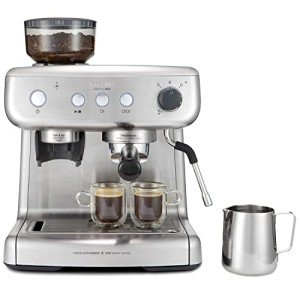Home Use Espresso Machines: A Comprehensive Guide
Espresso machines have become a staple in numerous households as coffee enthusiasts seek to replicate café-quality brews in the convenience of their cooking areas. The increase in appeal has actually caused a varied market filled with numerous models, features, and costs. This post intends to supply a helpful introduction of home use espresso machines, helping readers browse their alternatives successfully.
Understanding Espresso Machines
Espresso machines work by forcing warm water through finely-ground coffee under high pressure, leading to a focused coffee drink referred to as espresso. There are several kinds of espresso machines classified based on their developing techniques and level of automation. The most common types include:
- Manual Espresso Machines: These need the user to control the pressure and water flow, allowing for a more hands-on coffee-making experience.
- Semi-Automatic Espresso Machines: These use automatic control over water pressure, while the user by hand grinds and tamps the coffee.
- Automatic Espresso Machines: With the push of a button, these machines automatically manage the circulation of water, making it easier to brew espresso with constant outcomes.
- Super-Automatic Espresso Machines: These all-in-one machines handle grinding, tampering, developing, and even milk frothing, making them perfect for users looking for benefit.
- Pill or Pod Machines: These use pre-packaged coffee pods to create espresso with very little effort, however they restrict choice in developing strategies and flavors.
Table: Comparison of Espresso Machine Types
| Type | Control Level | Relieve of Use | Cleaning Level | Suitable For |
|---|---|---|---|---|
| Manual | User-controlled | Moderate | High | Coffee purists |
| Semi-Automatic | Partial automation | Moderate | Moderate | Home baristas |
| Automatic | Fully automated | Easy | Low | Hectic individuals |
| Super-Automatic | Totally automated | Very easy | Really low | Convenience applicants |
| Capsule/Pod | Completely automated | Really easy | Really low | Casual drinkers |
Key Features to Consider
When selecting a home use espresso machine, it's necessary to think about different functions that can considerably impact the quality of espresso and user experience.
- Pressure: Look for machines that offer at least 9 bars of pressure, as this is considered optimum for brewing espresso.
- Boiler Systems: Single vs. dual boiler systems figure out temperature stability and the capability to brew espresso and steam milk simultaneously.
- Grinder: Integrated grinders enable newly ground coffee, which boosts flavor. Think about machines with adjustable grind settings.
- Milk Frother: For those who enjoy coffees and lattes, an integrated steam wand or automatic frother is important.
- Size and Design: Consider your kitchen area and aesthetic preferences. Machines are available in various sizes, from compact to large setups.
- Price: Home espresso machines can range from a couple of hundred to a number of thousand dollars, so it's vital to establish a budget before exploring choices.
Advantages and disadvantages of Home Use Espresso Machines
| Pros | Cons |
|---|---|
| Benefit of developing coffee in your home | Initial investment can be high |
| Quality of espresso is typically remarkable | Requires some skill, especially with manual machines |
| Ability to try out flavors | Maintenance and cleaning can be labor-intensive |
| Can conserve cash in the long run | Not all machines will match every coffee preference |
Upkeep and Cleaning Tips
Maintaining an espresso machine is essential for extending its life and making sure consistent brew quality. Here are some beneficial tips:
- Regular Descaling: Minerals from water can develop in the machine. Descale every 1-3 months, depending on water firmness.
- Daily Cleaning: Rinse portafilters, baskets, and steam wands after each use to prevent coffee oils from constructing residue.
- Use Filtered Water: This can help in reducing mineral buildup and improve the taste of coffee.
- Replace Gaskets and Seals: These parts may wear out gradually and should be changed to maintain pressure and efficiency.
- Read the Manual: Each machine has specific care guidelines; following these will make sure durability.
FAQs About Home Use Espresso Machines
Q1: What is the very best budget espresso machine? Top Espresso Machines depends upon private requirements, but models like the DeLonghi EC155 or the Breville Bambino are popular among users for providing terrific value. Q2: How long do home espresso machines typically last?With correct upkeep, home espresso machines can last anywhere from 5 to 15 years, depending on the quality of the machine and frequency of use. Q3: Can I make cappuccinos and lattes with any espresso machine?While most espresso machines can make cappuccinos and lattes, having a reputable
steam wand or frother is important for achieving the ideal milk texture.
Q4: Are super-automatic machines worth the investment?For those who focus on convenience and quick brewing, super-automatic machines can be worth the investment, though they may lack some customizability in brew strength and flavor. Q5: What types of coffee beans are best for espresso?While homesite plays a role, beans identified as" espresso "blends are usually roasted darker, creating abundant flavors and a creamy texture when brewed.
Purchasing a home espresso machine can change the everyday coffee regimen into something special, raising home brews to café quality. By understanding the various kinds of machines, essential functions to think about, maintenance needs, and weighing the
pros and cons, consumers can make informed choices that suit their specific choices. As the espresso culture continues to grow, no matter the option, every brew can be a scrumptious experience waiting to be enjoyed.

